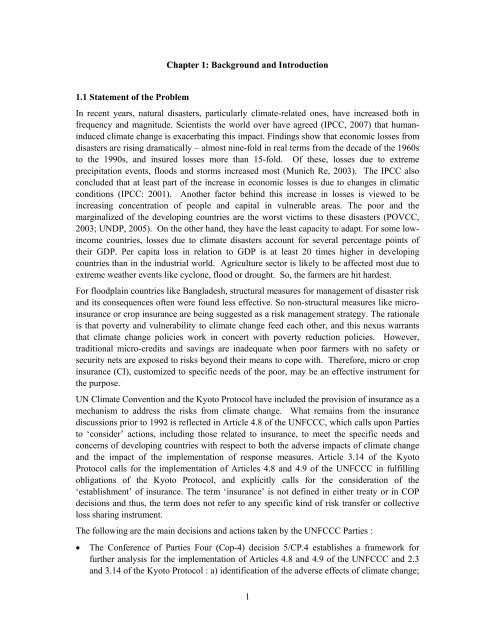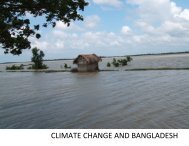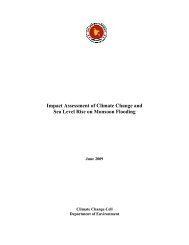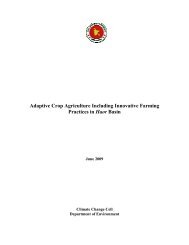Crop Insurance as a Risk Management Strategy in Bangladesh
Crop Insurance as a Risk Management Strategy in Bangladesh
Crop Insurance as a Risk Management Strategy in Bangladesh
You also want an ePaper? Increase the reach of your titles
YUMPU automatically turns print PDFs into web optimized ePapers that Google loves.
1.1 Statement of the Problem<br />
Chapter 1: Background and Introduction<br />
In recent years, natural dis<strong>as</strong>ters, particularly climate-related ones, have <strong>in</strong>cre<strong>as</strong>ed both <strong>in</strong><br />
frequency and magnitude. Scientists the world over have agreed (IPCC, 2007) that human<strong>in</strong>duced<br />
climate change is exacerbat<strong>in</strong>g this impact. F<strong>in</strong>d<strong>in</strong>gs show that economic losses from<br />
dis<strong>as</strong>ters are ris<strong>in</strong>g dramatically – almost n<strong>in</strong>e-fold <strong>in</strong> real terms from the decade of the 1960s<br />
to the 1990s, and <strong>in</strong>sured losses more than 15-fold. Of these, losses due to extreme<br />
precipitation events, floods and storms <strong>in</strong>cre<strong>as</strong>ed most (Munich Re, 2003). The IPCC also<br />
concluded that at le<strong>as</strong>t part of the <strong>in</strong>cre<strong>as</strong>e <strong>in</strong> economic losses is due to changes <strong>in</strong> climatic<br />
conditions (IPCC: 2001). Another factor beh<strong>in</strong>d this <strong>in</strong>cre<strong>as</strong>e <strong>in</strong> losses is viewed to be<br />
<strong>in</strong>cre<strong>as</strong><strong>in</strong>g concentration of people and capital <strong>in</strong> vulnerable are<strong>as</strong>. The poor and the<br />
marg<strong>in</strong>alized of the develop<strong>in</strong>g countries are the worst victims to these dis<strong>as</strong>ters (POVCC,<br />
2003; UNDP, 2005). On the other hand, they have the le<strong>as</strong>t capacity to adapt. For some low<strong>in</strong>come<br />
countries, losses due to climate dis<strong>as</strong>ters account for several percentage po<strong>in</strong>ts of<br />
their GDP. Per capita loss <strong>in</strong> relation to GDP is at le<strong>as</strong>t 20 times higher <strong>in</strong> develop<strong>in</strong>g<br />
countries than <strong>in</strong> the <strong>in</strong>dustrial world. Agriculture sector is likely to be affected most due to<br />
extreme weather events like cyclone, flood or drought. So, the farmers are hit hardest.<br />
For floodpla<strong>in</strong> countries like <strong>Bangladesh</strong>, structural me<strong>as</strong>ures for management of dis<strong>as</strong>ter risk<br />
and its consequences often were found less effective. So non-structural me<strong>as</strong>ures like micro<strong>in</strong>surance<br />
or crop <strong>in</strong>surance are be<strong>in</strong>g suggested <strong>as</strong> a risk management strategy. The rationale<br />
is that poverty and vulnerability to climate change feed each other, and this nexus warrants<br />
that climate change policies work <strong>in</strong> concert with poverty reduction policies. However,<br />
traditional micro-credits and sav<strong>in</strong>gs are <strong>in</strong>adequate when poor farmers with no safety or<br />
security nets are exposed to risks beyond their means to cope with. Therefore, micro or crop<br />
<strong>in</strong>surance (CI), customized to specific needs of the poor, may be an effective <strong>in</strong>strument for<br />
the purpose.<br />
UN Climate Convention and the Kyoto Protocol have <strong>in</strong>cluded the provision of <strong>in</strong>surance <strong>as</strong> a<br />
mechanism to address the risks from climate change. What rema<strong>in</strong>s from the <strong>in</strong>surance<br />
discussions prior to 1992 is reflected <strong>in</strong> Article 4.8 of the UNFCCC, which calls upon Parties<br />
to ‘consider’ actions, <strong>in</strong>clud<strong>in</strong>g those related to <strong>in</strong>surance, to meet the specific needs and<br />
concerns of develop<strong>in</strong>g countries with respect to both the adverse impacts of climate change<br />
and the impact of the implementation of response me<strong>as</strong>ures. Article 3.14 of the Kyoto<br />
Protocol calls for the implementation of Articles 4.8 and 4.9 of the UNFCCC <strong>in</strong> fulfill<strong>in</strong>g<br />
obligations of the Kyoto Protocol, and explicitly calls for the consideration of the<br />
‘establishment’ of <strong>in</strong>surance. The term ‘<strong>in</strong>surance’ is not def<strong>in</strong>ed <strong>in</strong> either treaty or <strong>in</strong> COP<br />
decisions and thus, the term does not refer to any specific k<strong>in</strong>d of risk transfer or collective<br />
loss shar<strong>in</strong>g <strong>in</strong>strument.<br />
The follow<strong>in</strong>g are the ma<strong>in</strong> decisions and actions taken by the UNFCCC Parties :<br />
• The Conference of Parties Four (Cop-4) decision 5/CP.4 establishes a framework for<br />
further analysis for the implementation of Articles 4.8 and 4.9 of the UNFCCC and 2.3<br />
and 3.14 of the Kyoto Protocol : a) identification of the adverse effects of climate change;<br />
1





